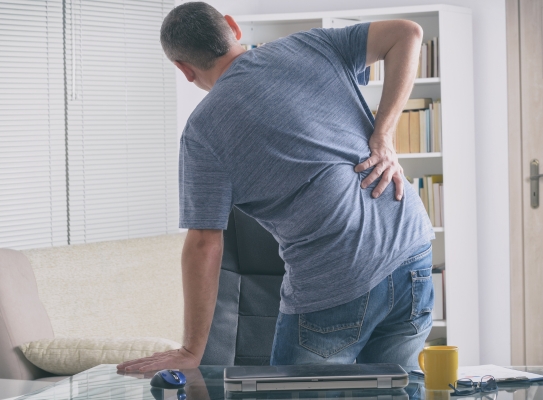Physiotherapy Treatments For Back Pain
What Is Back Pain?
Back pain is a prevalent medical issue in Canada. It can range from a persistent, dull ache to a sudden, sharp pain that radiates down the leg. Sometimes it arises suddenly, triggered by an accident, fall, or lifting heavy objects. Other times, it develops gradually due to age-related degenerative changes in the spine. Additionally, back pain can be caused by inflammatory arthritis disorders or other medical conditions.
Ways To Relieve Back Pain
Our physiotherapist can instruct you on exercises that enhance flexibility, strengthen the back and abdominal muscles, and promote better posture. Consistently incorporating these back pain treatments can assist in preventing pain recurrence. Additionally, our physiotherapist will educate you on modifying movements during episodes of back pain, allowing you to remain active while minimizing pain symptoms.

Who Experiences Back Pain?
Lower back pain, also known as lumbago, is not a distinct disease itself, but rather a symptom that can arise from various underlying medical conditions. Typically, it occurs as a result of issues affecting one or multiple components of the lower back.
- Ligaments and muscles
- Discs
- Intervertebral discs
- Nerves
- The spine consists of bony structures known as vertebral bodies or vertebrae.
Back pain can also stem from issues with neighboring organs, such as the kidneys. According to the American Association of Neurological Surgeons, a staggering 75 to 85 percent of Americans will encounter back pain at some point in their lives.
Remarkably, half of these individuals will have multiple episodes within a single year. The good news is that in 90 percent of cases, the pain improves without the need for surgery. However, if you are currently experiencing back pain, it is advisable to consult with one of our physiotherapists.
Questions to Ask Our Physiotherapy Team for Back Pain Relief!
- What could be the primary cause of my back pain?
- Are tests necessary?
- What back pain treatments approach would you recommend?
- I have additional medical conditions. How can I effectively manage them all simultaneously?
- How long will I need back pain treatments?
- What are some self-care strategies that I should consider?
- How can I effectively prevent the recurrence of back pain?
What To Expect From Our Physiotherapy Team?
Our team of physiotherapists will ask you questions, such as:
- Have you ever experienced a back injury?
- Does the pain persist without interruption?
- Does the pain impact your ability to function? If so, in what way does it affect you?
- Apart from the back pain, are there any other signs or symptoms you are experiencing?
- Do you engage in physically demanding labor?
- Do you engage in regular exercise? If so, what specific activities do you participate in?
- How frequently do you experience feelings of depression or anxiety?
- How well do you sleep?
- Have you attempted any treatments or engaged in any self-care practices thus far? If so, have you found any of them to be effective in alleviating your symptoms?

Back Pain Treatments You Can Do At Home
There are numerous home remedies that can complement for back pain treatments. If you have any inquiries regarding these remedies, it is advisable to consult our physiotherapy clinic Surrey.
Heat And Ice Therapy
Ice packs can provide relief and reduce inflammation during the initial stages of back pain. It’s important to note that direct application of ice to the skin should be avoided. To prevent any potential damage, it is recommended to wrap the ice pack in a thin towel or gauze before use.
Applying warm compresses can provide pain relief once inflammation subsides. Alternating between heat and cold can be beneficial.
Exercises
Incorporating exercises that enhance posture and strengthen the back and abdominal muscles, also known as the core muscles, should be given serious consideration as back pain treatments option.
These back pain treatments often involves:
- Enhancing posture.
- By employing appropriate lifting techniques,
- Improving core muscle strength.\Stretching muscles is a valuable practice to enhance flexibility.
- Our physiotherapists can provide you with guidance on performing these exercises in the comfort of your own home.
Back Pain - Symptoms And CausesCauses Of Back Pain
Lower back pain is commonly caused by strain and issues with the structures of the back.
Strain
Back pain is frequently caused by strained muscles. This strain typically arises from improper lifting of heavy objects and sudden, awkward movements.
Overactivity can also lead to strain. For instance, after a few hours of yard work or playing a sport, one may experience a sore feeling and stiffness.
Structural Problems
The spine is composed of interlocking bones called vertebrae, stacked upon each other. These vertebrae are separated by tissue-filled discs that provide cushioning. Back pain is often attributed to disc injuries, which are relatively common occurrences.
At times, these discs may bulge, herniate, or rupture, causing compression of the nerves.
Herniated discs can cause intense pain. When a bulging disc puts pressure on the nerve that runs from your back down to your leg, it can result in sciatica or irritation of the sciatic nerve. This may manifest as leg pain and discomfort.
- Pain
- Tingling
- Numbness
Arthritis
Spinal osteoarthritis can be a contributing factor to back pain. This condition occurs when the cartilage in the joints of your lower back deteriorates and becomes damaged.
Over time, this condition can cause the spinal column to become narrowed, resulting in a condition known as spinal stenosis.
Osteoporosis
Osteoporosis, a condition characterized by loss of bone density and thinning, can result in small fractures in the vertebrae. These fractures, known as compression fractures, can cause significant pain and discomfort.
Other Causes Of Back Pain
While back pain can stem from various factors, most of them are uncommon. It is advisable to consult a doctor for back pain treatments if you consistently experience persistent back pain. Once the more prevalent causes have been ruled out, your doctor will conduct tests to identify any potential rarer causes.
These tests may encompass:
- Degenerative spondylolisthesis refers to the displacement of a vertebra as it shifts out of its proper position and onto an adjacent vertebra.
- Cauda equina syndrome, a medical emergency, refers to the loss of nerve function in the lower spinal cord.
- Spinal infections, whether caused by fungi or bacteria such as Staphylococcus, E. coli, or tuberculosis, can pose a significant health concern.
- Tumor in the spine, whether cancerous or noncancerous (benign),
- Kidney infection or the presence of kidney stones
Symptoms Of Back Pain
Back pain can manifest in various ways, exhibiting a range of symptoms such as:
- A persistent, throbbing discomfort in the lumbar region.
- Experiencing a sharp and intense pain, resembling a stabbing or shooting sensation, that may extend from the leg all the way down to the foot.
- Experiencing difficulty in maintaining an upright posture without experiencing pain
- Limited range of motion and decreased flexibility in the back.
If back pain is caused by strain or misuse, the symptoms are typically temporary but can persist for days or even weeks.
Chronic back pain refers to the persistence of symptoms for a duration exceeding 3 months.
Back Pain Diagnosis
A physical examination is usually sufficient for diagnosing back pain. During this examination, our experienced physiotherapists may assess the following:
- Ability to stand and walk
- Spine’s range of motion
- Reflexes
- Leg strength
- Ability to detect sensations in your legs
Don’t Ignore These Back Pain Signs – They Could Signal Something Serious!
If your back pain persists for more than 2 weeks without improvement, it is advisable to consult with a medical professional for back pain treatments. It is important to recognize that back pain can sometimes indicate a more serious underlying medical condition.
Here are some symptoms that may indicate a more significant medical issue:
- Inability to control bowel or bladder functions.
- Experiencing numbness, tingling, or weakness in either one or both legs.
- Back pain following a traumatic event, such as a fall or a blow to the back, can be a common occurrence.
- Experiencing excruciating and relentless pain that intensifies during the night.
- Unexplained weight loss
- Abdominal pain accompanied by a pulsating sensation.
- Fever
If you experience any of these symptoms, please inform your doctor or our physiotherapy team.
Overview Of Back Pain And Back Pain Treatments
Back pain is a common ailment, and the older you get, the more likely you are to experience it. In fact, the majority of Canadians will cope with back pain at some point in their lives. For a small percentage, back pain may become chronic.
With back pain treatments, most episodes of back pain will resolve on their own. Occasionally, you will need help from your doctor in the form of prescription medication or injections. Surgery may be an option in very rare cases. If you had a surgery, here is the Guide to Post-Surgical Rehabilitation.
The good news for people who’ve experienced back pain and want to avoid another bout with it is that you can take steps to prevent back pain. Daily stretches, yoga, and strength training can help make your back and core muscles stronger and more resilient.

Unveiling The Culprits: Factors that Heighten the Risk of Back Pain
If you experience any of the following, you might be at a higher risk for back pain:
- Working in a sedentary (inactive) environment.
- Avoid exercising.
- Engaging in high impact activities without prior stretching or warming up.
- Are older
- Suffer from obesity.
- You smoke.
- If you have received a diagnosis for a specific condition, such as arthritis.
Your mental well-being can also impact your susceptibility to experiencing back pain. Individuals with demanding occupations or those battling depression and anxiety may find themselves at a heightened risk of developing back pain.
